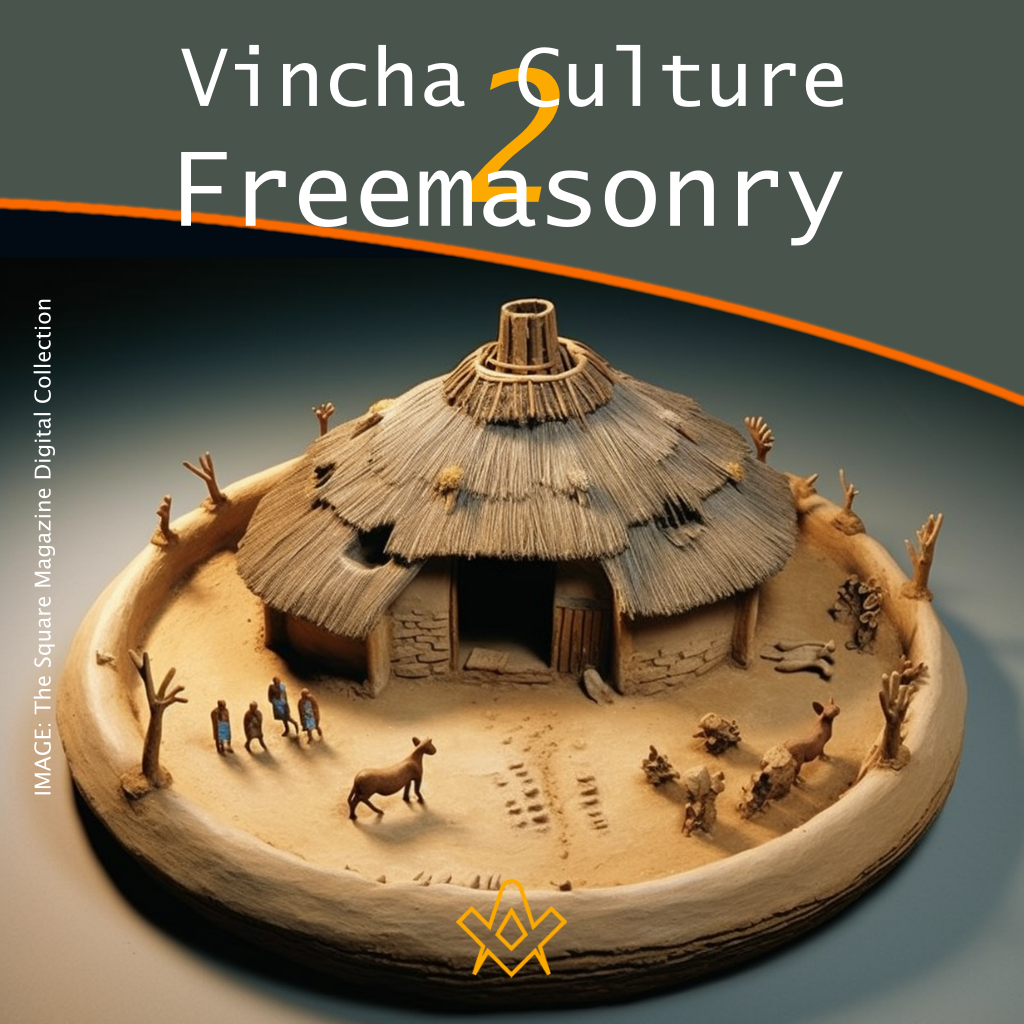From Vincha Culture to Freemasonry: The surprising connection between ancient building techniques and modern-day Masonic philosophy.
Every now and again, we all came across a word that we haven’t heard in a long time. Recently, I watched a documentary where an old Serbian word was used.
The word “shestarenye” (in Serbian Latin script: šestarenje and in Serbian Cyrillic: шестарење) translates to “circling” or “circumnavigation” in English.
Although the word is disappearing from common usage, it is still occasionally heard in conversation.
For example, an eagle flying high in the sky and circling would be sometimes said to be doing “shestarenye”, as would a freestyle-wrestler circumnavigating with his body while keeping his head firmly centered on the ground.
The noun form “shestarenye” translates literally into English as “a sixing”.
The root word of “shestarenye” is “shest”, which translates to “six” in English. This becomes significant when we examine the meaning of “shestar”, the Serbian word for compasses.
“Shestar” also has its roots in “shest”, and it translates to “a sixer” in English (something that performs or does six).
This raises the question of how the Serbian language came to use “sixer” to describe an instrument like compasses which are used for drawing circles.

compasses
IMAGE Credit: Alex Lishanin
To uncover the answer, we must look back 7,500 years to the Neolithic era and the dawn of the Vincha (Vinča – Винча) culture, a civilisation concentrated around the Danube River that spread across modern-day Serbia.
The Vincha culture, which succeeded its predecessor, the Starchevo (Starčevo – Старчево) culture, is considered to be the first and oldest urban civilisation in Europe, dating back to 5500 BCE.
The early Vincha settlements, both rural and urban, were characterised by circular pit houses and sunken-floor houses.
The reasons as to why the Vincha culture chose to build circular-shaped houses are still the subject of debate.
Some theories suggest that the circular shape represented the cyclical nature of life, while others propose that it was an easier shape to construct, or one that offered better ventilation and insulation.
It may simply have been a matter of cultural preference and the value placed on aesthetic and symbolic qualities.
In any case, it is clear that the Vincha culture’s use of circular shapes influenced the Serbian language and led to the use of “shestar” and “shestarenye” in modern-day Serbian.
The people of Vincha were skilled in constructing circular pit and sunken-floor houses, which suggests that they had a good understanding of circular shapes and measurements.
Their proficiency in geometry can also be seen in the motifs found on their pottery and other artifacts.
The knowledge of mathematical relationships between the diameter and circumference of circles was essential to building such houses.
One of the most important pieces of evidence of their understanding of these measurements and mathematical calculations is the tool known as the “sixer” (compasses) and the activity known as “sixing (circumvention and use of circle’s diameter to split the circle in its equal parts), which in their time was nothing more than a couple of sticks and a piece of string.
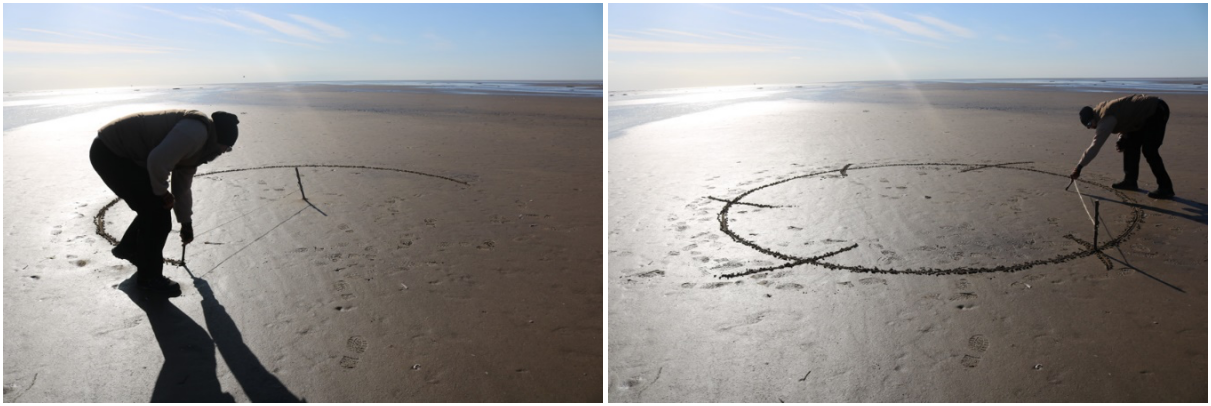
left: Making a Circle (the author using sticks and rope – the original compasses)
right: Dividing the Circle
IMAGE Credit: Alex Lishanin
With the advancement of their civilisation, the Vincha culture saw the emergence of trapezoid-shaped houses, which were built across various settlements and were characterised by increased urbanisation, trade, and technological development, including the use of copper metallurgy.
Lepenski Vir is one of the famous settlements that overlapped from Starchevo into Vincha culture. The Vincha society was harmonious and existed through a long peaceful period, as there were no fortifications or defence mechanism around their settlements.
They were based on egalitarian principles where members were treated equally. However, the social, trading, and technological developments brought a new understanding of ownership, which led to a growing shift from egalitarianism, towards concepts of ownership and control.
The trapezoid-shaped houses built in urban areas represented the connection to the natural world.
The suggested functionality of trapezoid-shaped houses were related to social organisation and community building.
The standardisation of house size and shape allowed for more organised and efficient use of space, which facilitated living arrangements and social interaction.
The uniformity of the houses reinforced social norms and shared values within the community. The trapezoid-shaped houses in Vincha culture had multiple symbolic and practical functions that contributed to the overall organisation and harmony of society preserving egalitarian ideas and values.
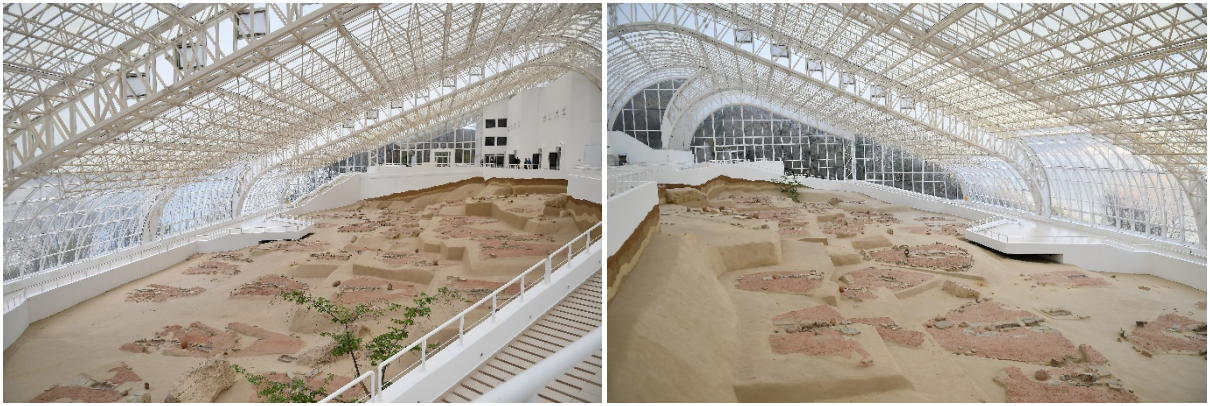
Lepenski Vir Archeological site
IMAGE Credit: M. Azdejkovic
According to Dr. Dragoslav Srejović, an Associate Professor of Archaeology at the University of Belgrade, the trapezoid-shaped houses found in Vincha culture were cut-out segments from a circle, specifically one-sixth of a circle.
In his article “Lepenski Vir, the first planned settlement in Europe” (Source: Ekistiks, November 1974, Vol. 38, No. 228); Dr. Srejović describes the foundations of all the houses in the Lepenski Vir settlement as forming “the sector of a circle with subtended angle of 60⁰.”
He goes to explain that this shape can be established using only a system of triangulation, and that the isosceles triangle is noticeable in the foundations of all the houses that have been discovered.
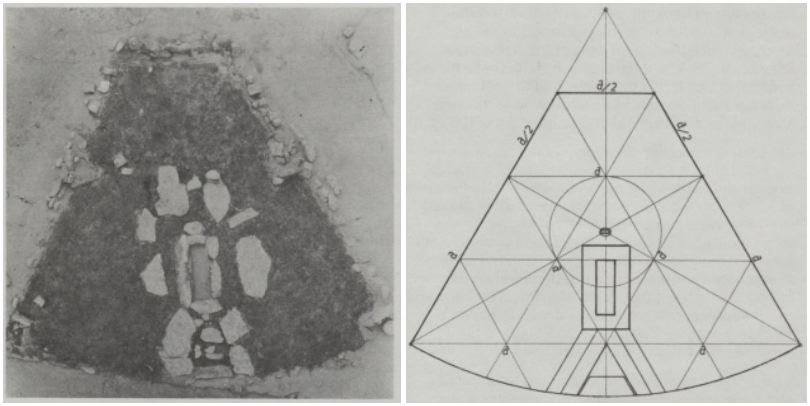
left: Photograph of a house plan showing disposition of objects Dr Srejovic
right: Schematic presentation of a typical house Dr Srejovic
IMAGE Credit: Ekistiks, November 1974, Vol. 38, No. 228
Dr. Srejović further explains that “due to the practical reasons, the point of triangle at the rear of the house is sliced off and the frontage of the house is always extended by an arc.
These modifications were not carried out in an arbitrary way. The rear was shortened by exactly one quarter of the height of a primary triangle, and the frontage extended by drawing an arc from the rear apex with a radius equal to the crossbeam on the frontage.”
He notes that the supports from the main props of the roof structure were placed so that if lines were drawn connecting them, an isosceles triangle would also be formed.
The central point of this internal triangle coincides with the central point of the original triangle, so that the foundation of the house may be considered as a developed tetrahedral area with a truncated triangle at the rear.
This discovery sheds light on the advanced knowledge of geometry possessed by the Vincha people, as well as their skill in utilising this knowledge to build their homes.
In addition to the fascinating architectural wonders of Vincha settlements, another intriguing discovery has been made in their burial practices.
Archaeologists have unearthed burials where the deceased were found in a seated, cross-legged position, which has led experts to suggest it held significant meaning to the people of this ancient culture.
Some have speculated that the seated position may have been a symbol of rebirth or renewal, representing a new beginning for the soul in the afterlife.
Additionally, the incorporation of the human form into the design of the buildings, as suggested by Dr. Srejović, further highlights that intricate and thoughtful nature of their architecture.
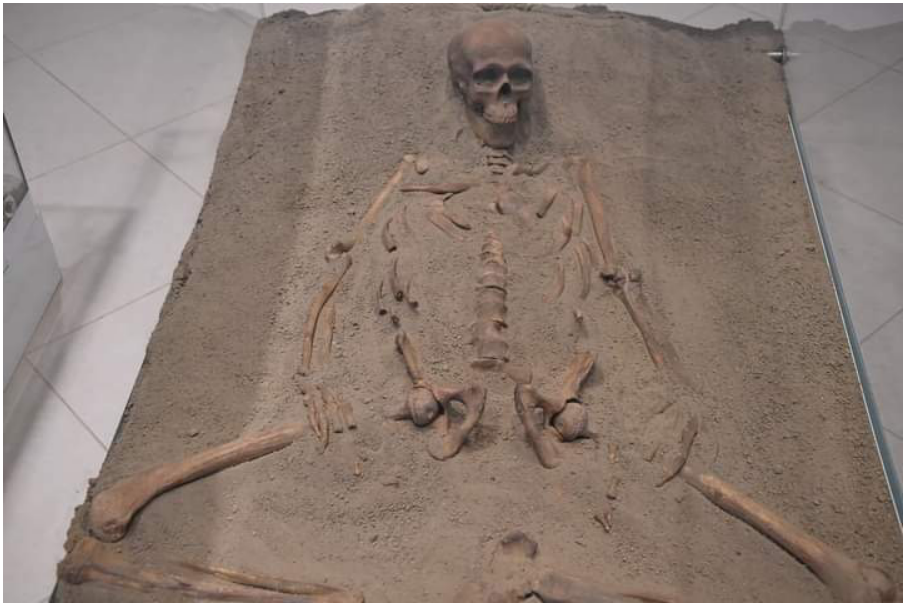
Lepenski Vir Archeological site, skeleton in a cross-legged position.
IMAGE Credit: M. Azdejkovic
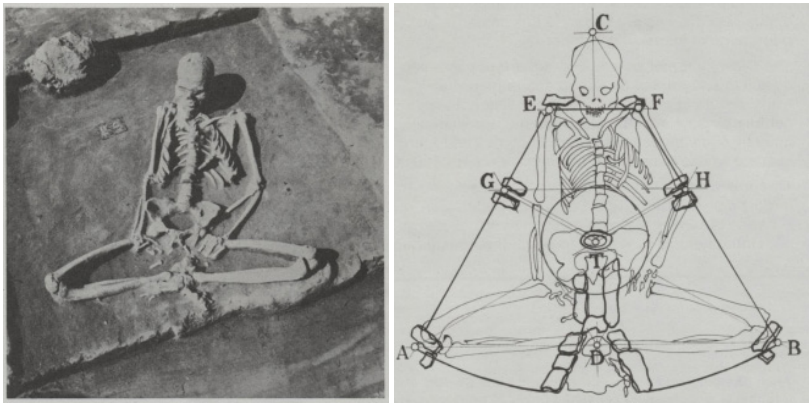
left: Skeleton in a cross-legged position Dr Srejovic
right: Schematic presentation of a typical house Dr Srejovic
IMAGE Credit: Ekistiks, November 1974, Vol. 38, No. 228
It is fascinating to see, how the people of the Vincha culture used their knowledge of geometry to build their circular and trapezoid-shaped houses.
The use of circles and triangles in their architecture reveals a deep understanding of mathematical principles and appreciation of the natural world.
This knowledge of geometry had been passed down through history and it is still used today in the field of stonemasonry.
Furthermore, the principles of geometry and symbolism in the architecture of Vincha culture can also be traced to Freemasonry.
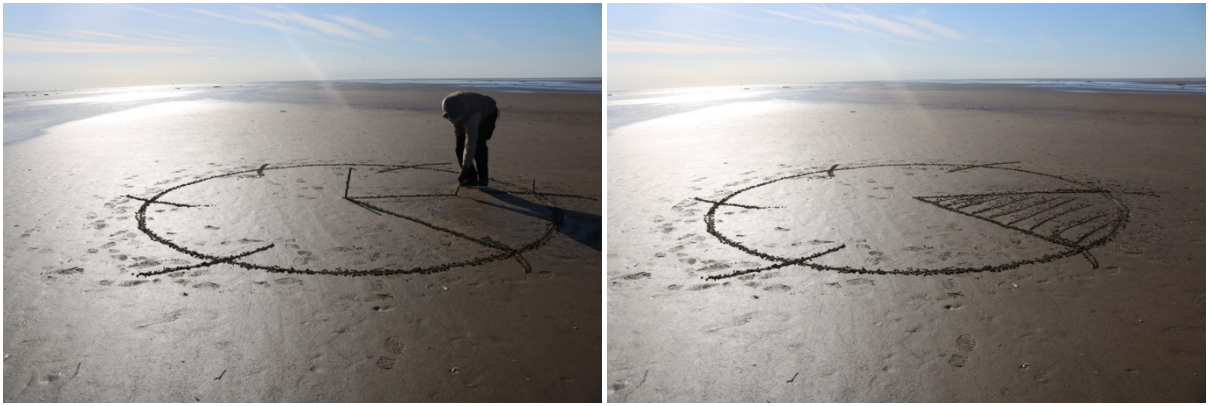
left: Making a triangle (the author using sticks and rope)
right: Equilateral triangle – base for house foundations
IMAGE Credit: Alex Lishanin
The use of circles, triangles and other shapes in architecture and stonemasonry, as well as their incorporation into the teachings of Freemasonry, highlights the enduring importance of geometry and symbolism in human culture.
These principles continue to inspire us to this day, reminding us of the power of the natural world and the enduring legacy of ancient knowledge and wisdom.
Moreover, the egalitarian view of the Vincha people is also mirrored in Freemasonry. Freemasonry’s belief in the equality of all men, regardless of their social status, is evident in its practices and symbols.
The equilateral triangle represents balance, harmony and stability, as well as the three primary tenets of Freemasonry: brotherly love, relief, and truth. These values are integral to Freemasonry, and the triangle serves as a reminder of the importance of upholding them.
Additionally, the three degrees of initiation in Freemasonry, which are represented by the equilateral triangle, emphasise the idea of continual growth and improvement.
The enduring legacy of the Vincha culture’s use of equilateral triangle for their trapezoid-shaped houses is a testament to the enduring importance of nature’s geometrical shapes in human society.
In conclusion, the use of circles and triangles in building has a rich history that dates back thousands of years, from the innovative design of the trapezoid-shaped houses in the Vincha culture to the incorporation of these shapes in the architecture and symbolism of Stonemasonry and Freemasonry.
It is fascinating to see how these ancient concepts still resonate with us today, reminding us of the ingenuity and creativity of our ancestors.
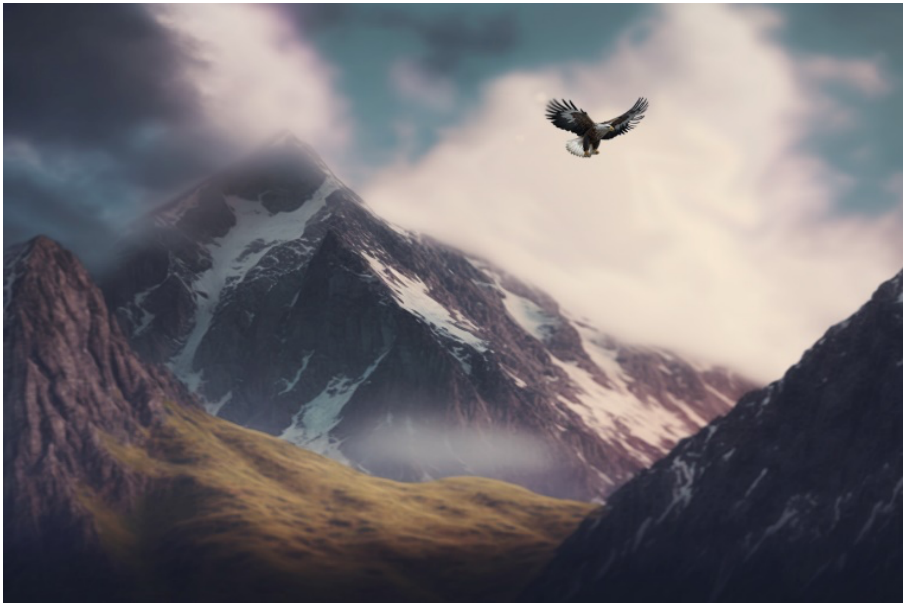
Eagle circling the sky
IMAGE Credit: Alex Lishanin
Now, whenever I look in the sky and see an eagle circling, I remember the word “shestarenye” which takes me back in time almost 8 millennia when our ancestors, the first builders of Europe used a simple stick and a rope to design intricate houses using the knowledge of geometrical methods known as “sixing” or dividing a circle into its six equal triangular parts.
It is a testament to the timeless wisdom and beauty of these shapes, and the human desire to understand and create beauty in the world around us.
Footnotes
Image References
Fig. 1 – Compasses (Alex)
Fig. 2 – Making Circle (Alex using sticks and rope – the original compasses)
Fig. 3 – Dividing Circle (Alex, using sticks and rope)
Fig. 4 – Lepenski Vir Archeological site (photo by an acquaintance)
Fig. 5 – Lepenski Vir Archeological site (photo by an acquaintance)
Fig. 6 – Photograph of a house plan showing disposition of objects Dr Srejovic (Source: Ekistiks, November 1974, Vol. 38, No. 228)
Fig. 7 – Schematic presentation of a typical house Dr Srejovic (Source: Ekistiks, November 1974, Vol. 38, No. 228)
Fig. 8 – Lepenski Vir Archeological site, Skeleton in a cross-legged position (photo by an acquaintance)
Fig. 9 – Skeleton in a cross-legged position Dr Srejovic (Source: Ekistiks, November 1974, Vol. 38, No. 228)
Fig. 10 – Schematic presentation of a typical house Dr Srejovic (Source: Ekistiks, November 1974, Vol. 38, No. 228)
Fig. 11 – Making triangle (Alex, using sticks and rope)
Fig. 12 – Equilateral triangle – base for house foundations (Alex, using sticks and rope)
Fig. 13 – Eagle circling the sky (Alex – Midjourney)
Article by: Alex Lishanin
Recent Articles: masonic history
 Protestantism and Masonic Influence in Brazil Discover the untold story of how Freemasons helped Southern Americans immigrate to Brazil post-Civil War, fostering economic and educational growth in Santa Bárbara d’Oeste and Americana. Learn about their pivotal role in establishing Protestant churches and ensuring the secularity of the Brazilian State amidst a Catholic-dominated society. |
 Explore the proper use of the sacred word in Brazilian Freemasonry through an analysis of Masonic literature and Bible translations. Uncover the errors in pronunciation and the need for corrections to maintain liturgical coherence in rituals. Discover insights on Masonry, rituals, and the Hebrew word Boaz. |
 Narratives of History |
 A Very Royal Sesquicentenary |
 Unveiling the Enigma: Discover the Royal Society's Legacy and its Impact on Science. Delve into the fascinating history of the Royal Society, the prestigious UK academy shaping scientific progress since 1660. Explore its pivotal role in advancing knowledge, fostering collaboration, and unlocking the secrets of the universe. Prepare to be amazed! |
 Knights Templar in Freemasonry Uncover the Mysteries of the Knights Templar in Freemasonry! Delve into the intriguing world where chivalry and symbolism intertwine. Discover the captivating rituals and ancient secrets behind the Knights Templar Masonic Orders. Explore the historical connection and delve into the enigmatic narratives that continue to fascinate enthusiasts today. Unveil the hidden truths now! |
 The Royal Arch stands as the rainbow of promise in the Ritual; it stands as the promise of the resurrection; of that which was lost and that it shall be recovered. The question arises as to whether the Master's Word was originally communicated in the Third Degree? On this point there is some diversity of opinion. Originally published in 1915, this insight into the Fourth Degree – the Holy Royal Arch – is as relevant today as it was over 100 years ago. |
 Unveiling the Mysteries of Druidism: Discover the Intriguing Connection with Freemasonry. Explore the ancient spiritual practice of Druidism and its fascinating ties to the enigmatic world of Freemasonry. Delve into the shared symbolism and rituals that have captivated minds for centuries. Unlock the secrets of these intertwined traditions today! |
 Uncover the legacy of freestone masons and their pivotal role in crafting medieval cathedrals. Discover the artistry behind their techniques, the hierarchy within their craft, and the enduring impact of their intricate carvings. A deep dive into the world of these master craftsmen awaits you! |
 Unearth the intriguing journey from Vincha Culture to Freemasonry. Discover how ancient building methods intertwine with modern Masonic philosophies. This exploration will shed light on the fascinating link between the Serbian term "shestarenye" and the symbolic significance of the compass in Freemasonry. |
 Freemasonry and the Illuminati Unravel the enigmatic world of Freemasonry and the Illuminati in our latest exposé. Dive into centuries-old mysteries, debunk conspiracy theories, and discover the truth behind these elusive societies. Are they puppet masters or mere myths? Join us as we dissect history and fact from fiction. |
 The Île des Templiers, or “Island of the Templars” lies within a leafy park in Paris. The execution site of Jacques du Molay, the last Grand Master of the Knights’ Templar bears a plaque with the epitaph ‘A cet endroit / Jacques de Molay / Dernier grand maître / de l'ordre du temple / a été brûlé le 18 Mars 1314’ (‘In this location / Jacques de Molay / Last grand master / of the order of the temple / was burned on 18 March 1314’) |
 Operative Progressions to Speculative Masonry Both Operative and Speculative Masonry are an important part of the modern fraternity of Freemasonry, which combines elements of both traditions. Today, Freemasonry is a fraternity that is open to men of good character, who are interested in personal development and in making a positive contribution to their communities. |
 General Regulations of a Free Mason, 1723 General Regulations of a Free Mason as contained in Anderson's Constitutions of the Freemasons, published 1723. the Regulations are of great historical interest. Compiled by George Payne, the second Grand Master of the Premier Grand Lodge of England, they were printed in 1722/3, thus published just over five years after the formation of the Grand Lodge 1717. |
 The Genesis of the 1723 Book of Constitutions 2023, marks the three hundredth anniversary of the publication of the first printed Book of Constitutions of the Grand Lodge formally established in London two years previously. This is an anniversary whose significance extends beyond freemasonry. A paper by Andrew Prescott |
 The Ritual of the Operative Free Masons - P3 Existing Operative Free Masons. The ritual I am about to refer, is that of "The Worshipful Society of Free Masons, Rough Masons, Wallers, Slaters, Paviors, Plaisterers, and Bricklayers." By Thomas Carr, M.D., P. M. Honorary Member of the Guild of Operative Free Masons |
 Liberté chérie was a Masonic Lodge founded in 1943 by Belgian Resistance fighters and other political prisoners at Esterwegen concentration camp. It was one of the few lodges of Freemasons founded within a Nazi concentration camp during the Second World War. |
 The Ritual of the Operative Free Masons - P2 If anyone doubts the fact that the formation of Speculative Free Masonry was due to and based upon Operative Free Masonry, it is quite easy to convince him of his error if he will only study the first Book of Constitutions. By Thomas Carr, M.D., P. M. Honorary Member of the Guild of Operative Free Masons |
 In 1881, Freemasonry rose from the ashes of a fire in the mining town of Kokomo, Summit County, Colorado. Corinthian Lodge No. 42, along with Kokomo, no longer exists but it holds the record of having been – at an elevation of 10,618 feet – the highest Masonic Lodge in the USA. |
 The Huguenots and Early Modern Freemasonry The Huguenots influence in the development of early modern Freemasonry at the time of the formation of the Grand Lodge in London around 1717 / 1723. |
 November is a month of reflection – perhaps due to the fact that we are getting close to the years' end – but also because Remembrance / Armistice Day (11 November) is a significant date in most countries' diaries. |
 Speculative Freemasonry, as practise by Grand Lodge of England, was officially born just over three hundred years ago, is today an international organisation, counting over six million members. It has been subjected to persecution, suppression, and abolition throughout its history. In its infancy, only a couple of decades after its official birth, it had already become a target. |
 The Ritual of the Operative Free Masons - P1 The original paper was written, first, to prove that Speculative Free Masonry was derived from Operative Free Masonry; second, to give some account of the Operative Free Masons, of their Ritual, and of their customs. By Thomas Carr, M.D., P. M. Honorary Member of the Guild of Operative Free Masons |
 American Fraternalism in the 19th and Early 20th Centuries The late 19th and early 20th centuries in the United States has been called the "Golden Age of Fraternalism." How did this come about and why was the idea of joining a fraternal organization so popular? We will explore this question and examine the regalia used by many fraternal organizations in this period. |
 Societas Draconistarum, meaning "Society of the Dragonists"– was a chivalric Order for selected nobility, founded in 1408 by Sigismund von Luxembourg, who through marriage became the King of Hungary (1387–1437) and later Holy Roman Emperor. The Order was fashioned after the military orders of the Crusades, requiring its initiates to defend the cross and fight the enemies of Christianity, in particular the Ottoman Empire. |
 The Perjured Free Mason Detected Was Samuel Prichard a perjured individual, or simply a misguided Freemason? Prichard's book "Free Masonry Dissected" published in 1730, is now used by many Masonic historians as a source of reference with regards to the introduction of the third degree into the Craft. But at the time it was published in 1730, it was not so well received by members of the Grand Lodge of England. |
 17th century and the Holy Royal Arch This article focuses on a period of transition between a point in time when we can safely and historically identify the first formation of what could be called as the ‘Royal Arch’ and the historical events that have preceded it. |
 Most Freemasons have heard the terms 'Operative' and 'Speculative' Masons, and this article helps to understand the difference: |
 Roberts' Constitutions of Freemasonry 1722 Published a year before Anderson's Constitutions, The Old Constitutions Belonging to the Ancient and Honourable SOCIETY OF Free and Accepted MASONS. Originally printed in London England; Sold by J. Roberts, in Warwick-Lane, MDCCXXII.(1722) |
 From 'Songs of religion and life', 1876 by John Stuart Blackie (1809-1895) |
 On the Antiquity of Masonic Symbolism Is the Symbolism of Masonry an inheritance derived from the old Masons who flourished before the era of the Grand Lodges (1717); or has it been borrowed from the Rosicrucians or others, after 1717? |
 Mason's Marks – from Egypt to Europe? Mason's marks have been a source of intrigue, not only to Freemasons but to historians and archaeologists. The use of simple pictograms have been employed for millennia by artisans to identify their work. But where did they originate and why? |
 The White House Foundation Stones Further to the articles in our series on the history of the stone masons, we have a rather intriguing addition. During the 1950's renovation of the White House, President Truman retrieved more than 100 stone blocks with stonemasons marks. |
 What the Goose and Gridiron Tavern is in the ancient annals of London Freemasonry, The Green Dragon Tavern is to the memories of the Free-mason, of Boston and New England. |
 Auschwitz concentration camp: video photo article taken in 2013 |
 There are two things of importance happening this day - 27 January |
 Two approaches regarding the understanding of Freemasonry |
 Masonic Research in England c1930 An article which appeared in an American Masonic magazine, c1930 and which was reproduced in England, provoking a little controversy. |
 Masonic bookplates the ‘Brethren’s spiritual coats of arms and marks’ |
 The Unlawful Societies Act of 1799 Rebellious Freemasons and the 21st century |
 In 1912, Sarah Dowd of Dromore, Ireland, found a Masonic jewel dated 1517 - a date two hundred years before the establishment of Grand Lodge... |
 Freemasonry and Fascist Regime Interesting speech by the famous historian Prof. Aldo A. Mola, who links the fascist regime with the Masonic Associations. |
 Was famous Russian poet Alexander Pushkin a Freemason? And if so, was he a member of the lodge ‘for which all the lodges in Russia were destroyed’? |
 The Importance of Masonic Research Why is accurate - or authentic - Masonic research so important? The importance of making a daily advancement in Masonic knowledge is something that The Square is passionate about promoting. |
 The Antient Noble Order of the Gormogons had a brief existence in the eighteenth century; they left few records or accomplishments, |
masonic knowledge
to be a better citizen of the world
share the square with two brothers

click image to open email app on mobile device



